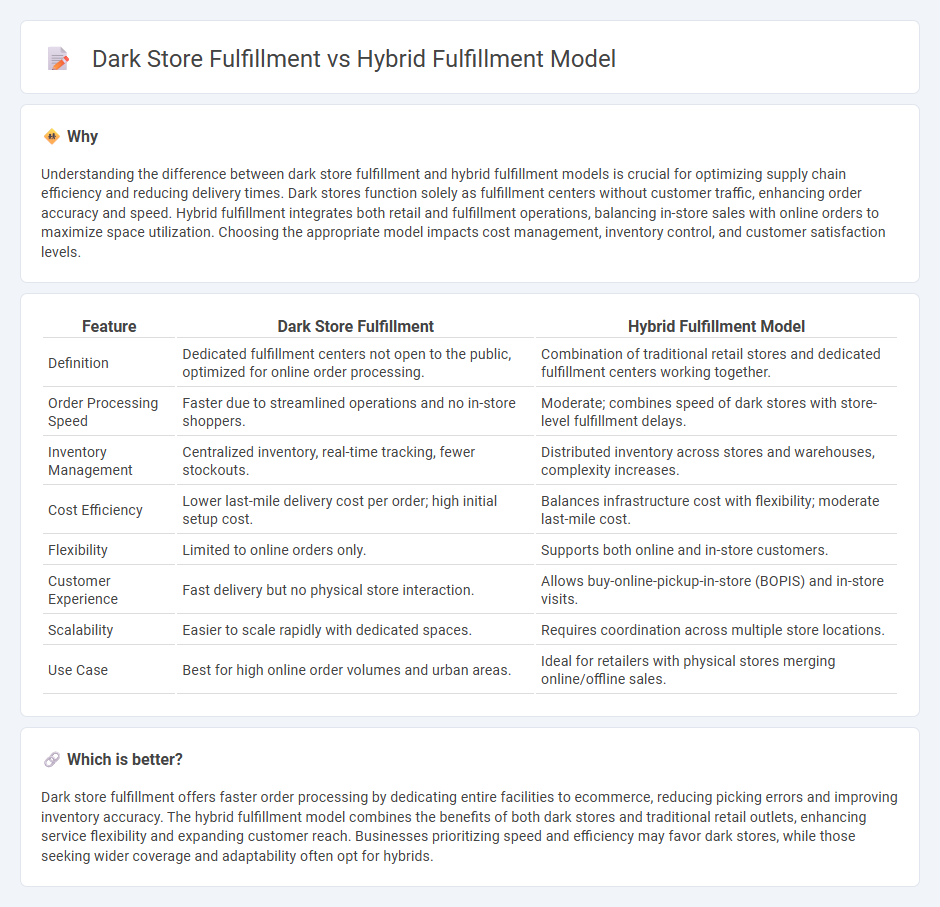
Dark store fulfillment operates through dedicated warehouses optimized solely for online order processing, enabling faster delivery and higher inventory accuracy. Hybrid fulfillment blends dark store efficiency with traditional retail picking, leveraging physical storefronts to fulfill orders while maintaining in-store shopping experiences. Discover deeper insights into how each model can transform your supply chain strategy.
Why it is important
Understanding the difference between dark store fulfillment and hybrid fulfillment models is crucial for optimizing supply chain efficiency and reducing delivery times. Dark stores function solely as fulfillment centers without customer traffic, enhancing order accuracy and speed. Hybrid fulfillment integrates both retail and fulfillment operations, balancing in-store sales with online orders to maximize space utilization. Choosing the appropriate model impacts cost management, inventory control, and customer satisfaction levels.
Comparison Table
| Feature | Dark Store Fulfillment | Hybrid Fulfillment Model |
|---|---|---|
| Definition | Dedicated fulfillment centers not open to the public, optimized for online order processing. | Combination of traditional retail stores and dedicated fulfillment centers working together. |
| Order Processing Speed | Faster due to streamlined operations and no in-store shoppers. | Moderate; combines speed of dark stores with store-level fulfillment delays. |
| Inventory Management | Centralized inventory, real-time tracking, fewer stockouts. | Distributed inventory across stores and warehouses, complexity increases. |
| Cost Efficiency | Lower last-mile delivery cost per order; high initial setup cost. | Balances infrastructure cost with flexibility; moderate last-mile cost. |
| Flexibility | Limited to online orders only. | Supports both online and in-store customers. |
| Customer Experience | Fast delivery but no physical store interaction. | Allows buy-online-pickup-in-store (BOPIS) and in-store visits. |
| Scalability | Easier to scale rapidly with dedicated spaces. | Requires coordination across multiple store locations. |
| Use Case | Best for high online order volumes and urban areas. | Ideal for retailers with physical stores merging online/offline sales. |
Which is better?
Dark store fulfillment offers faster order processing by dedicating entire facilities to ecommerce, reducing picking errors and improving inventory accuracy. The hybrid fulfillment model combines the benefits of both dark stores and traditional retail outlets, enhancing service flexibility and expanding customer reach. Businesses prioritizing speed and efficiency may favor dark stores, while those seeking wider coverage and adaptability often opt for hybrids.
Connection
Dark store fulfillment utilizes dedicated retail spaces optimized for online order processing, enabling faster and more efficient last-mile delivery. The hybrid fulfillment model integrates dark stores with traditional retail outlets, leveraging both inventory pools to enhance order flexibility and reduce fulfillment time. This connection improves supply chain responsiveness by balancing centralized dark store efficiency with decentralized store accessibility.
Key Terms
Inventory Management
A hybrid fulfillment model integrates traditional store inventory with dedicated warehouse stock, optimizing product availability and reducing stockouts across multiple channels. Dark store fulfillment centralizes inventory in warehouses designed solely for online order processing, improving picking efficiency but limiting immediate physical customer access. Explore more to understand how these strategies impact inventory turnover and customer satisfaction.
Order Processing
The hybrid fulfillment model integrates traditional storefronts with dedicated distribution centers to optimize order processing speed and inventory management, balancing consumer pickup and online delivery demands. Dark store fulfillment relies exclusively on conversion of retail spaces into localized warehouses, accelerating order picking and reducing last-mile delivery times through concentrated inventory access. Explore the advantages of each model for enhancing operational efficiency and customer satisfaction in order fulfillment.
Last-Mile Delivery
Hybrid fulfillment models blend traditional retail stores and dedicated fulfillment centers to optimize last-mile delivery speed and flexibility, leveraging store inventory for quicker customer pickups and deliveries. Dark store fulfillment relies exclusively on specialized, non-customer-facing warehouses designed to streamline order processing and maximize delivery efficiency in urban areas. Explore the advantages and applications of each approach to enhance your last-mile delivery strategy.
Source and External Links
Hybrid Fulfillment: Definition and Types - Inbound Logistics - Hybrid fulfillment is a strategic approach combining different fulfillment methods like in-house and third-party logistics to efficiently meet customer demands, giving businesses control, scalability, and flexibility.
Is hybrid order fulfillment your scalability secret? - Hybrid order fulfillment mixes multiple partners or operations across channels or product types, letting companies scale by outsourcing selectively while retaining operational control.
What is Hybrid Fulfillment? - Flowspace - Hybrid fulfillment combines company-owned warehousing with third-party or outsourced fulfillment locations to expand networks and optimize scale for growing or enterprise brands.
 dowidth.com
dowidth.com